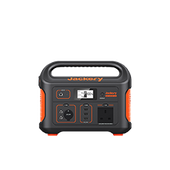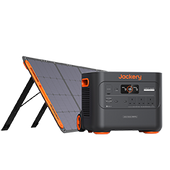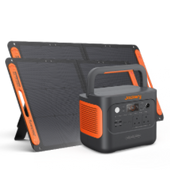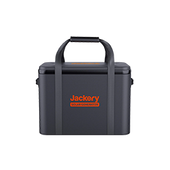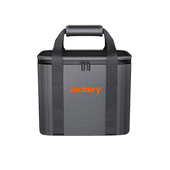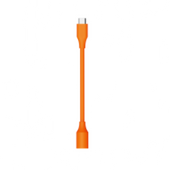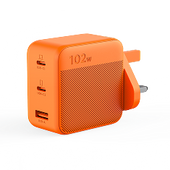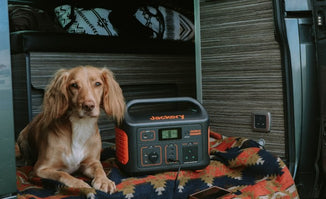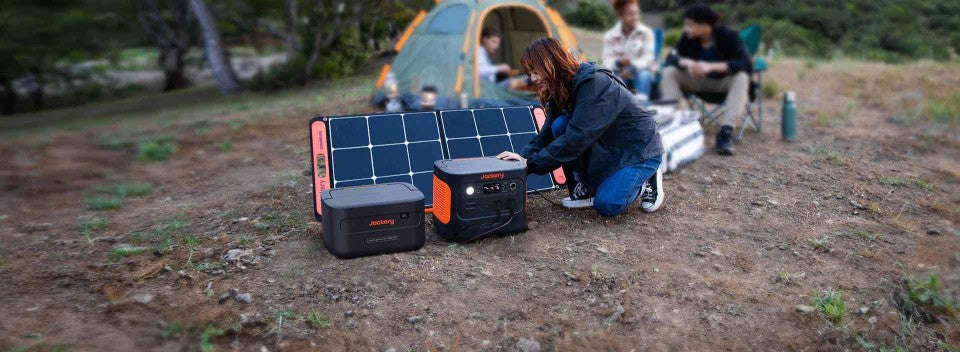Solar panels are known to create electricity, which helps individuals become less dependent on the national grid. But just how much electricity do solar panels produce? Is it realistic to anticipate having all the electricity you need from solar panels?
This article will discuss how much electricity a solar panel produce and the different factors that affect solar output.
Solar panels usually produce electricity from 80W to 500W. As for Jackery Solar Panels, there are 40W, 80W, 100W, and 200W solar panels, and they combine solar panels with a Portable Power Station to use solar energy fully.
|
Key Takeaways: |
|
- Solar panel output is the amount of electrical power a solar panel can produce when exposed to sunlight and is typically measured in watts (W) or kilowatt hours (kWh). - A detailed introduction to the factors that affect solar panel output: solar irradiance, insolation, panel efficiency, size and types of solar panel, climate, temperature, etc. - Here, we introduce Jackery Solar Generator 2000 Plus, 1000 v2, and 300 Plus to combine SolarSaga solar panels with Explorer power stations. |
What Is Solar Panel Output?
Solar panel output is the amount of electrical power a solar panel can produce when exposed to sunlight and is typically measured in watts (W) or kilowatt hours (kWh). A solar panel's wattage measures how much energy it can produce under standard testing conditions. Manufacturers use Standard Test Conditions (STC) to rate solar panel output and performance. It involves placing the panels under specific laboratory conditions, including:
- Exposure to an irradiance or light energy of 1,000 W per square meter.
- A cell temperature of 25C (77F).
- An air mass of 1.5 spectra or AM1.5. This imitates sunlight passing through the atmosphere at an angle of 48.19 degrees.
The standardised settings enable manufacturers to measure and report key performance metrics, making it easier to compare the power outputs of different solar panels. However, various factors could cause the actual power output to fluctuate in real-world scenarios. For example, an average 350W solar panel in the UK will provide 265kWh of electricity.
How Much Electricity Does A Solar Panel Produce?
You'll need to follow a basic equation to determine how much power your solar panels generate daily. To find out, multiply your solar system's power in kilowatts by the average hours of direct sunlight per day.
That gives you your solar system's daily production of energy in kilowatts. As a reference, a 1kW solar system can produce around 2.3kWh on average. Since solar power generation depends on several factors like the panel's capacity, sun exposure, and more, the amount of power generated per day may vary.
It's important to remember that adding a solar panel array to your roof can help you no matter where you reside in the UK. However, the amount of electricity your solar PV array will generate will differ based on the average annual sunshine hours you receive.
For illustration, a solar PV system installed in the South West of England will generate up to 30% more electricity than one installed in the Shetland Islands of Scotland. The map below shows the incidents of solar radiation in the UK over one year; as you can see, the annual average varies across the country.

In the UK, a 400-watt solar panel typically produces 340 kilowatt-hours (kWh) per year. According to government data, if you get ten panels installed, they'll usually generate 3,400kWh - the average UK home's annual electricity consumption.
Your system's output will depend on a variety of factors, though, including its size and efficiency, your roof's angle and direction, and your home's location.
What Can Affect The Solar Panel Output?
Before examining solar panels' power output and operation, it's critical to comprehend the significant variables affecting how much electricity a solar panel produce.
Solar Irradiance
Solar irradiance can be defined as the brightness or intensity of the sun at a given location and time. The amount of solar energy received per unit of area, or W/m^2, is the standard unit of measurement for solar irradiance.
It is possible to determine how much power a solar panel can capture by measuring sun irradiance. The average sun irradiation in the UK is approximately 101 W/m^2. In the south of England, it is 128.4 W/m^2, while in the northwest of Scotland, it is 71.8 W/m^2. But this value can skyrocket on very sunny days, especially in the summer, typically ranging from 600 to 800W/m^2.
Solar Insolation
Solar insolation, kWh/m2, is the total quantity of solar energy received at a specified location over a given period. Measuring solar insolation provides a comprehensive view of energy output, whereas measuring solar irradiance provides a moment in time. In the UK, insolation varies from 750 to 1,100 kWh/m2 annually. Using the midpoint value of 925kWh/m2 per year translates to an average of approximately 2.53kWh/m2 daily.
Panel Efficiency
The percentage of incident solar energy - radiant solar energy that reaches Earth - that a solar panel can transform into electrical power that can be used is known as efficiency. The efficiency of a solar panel typically falls between 15% and 22%.
For example, a high-efficiency panel: A 20% efficient solar panel converts twenty out of every 100 watts of solar radiation into usable electrical power. Moderately efficient solar panel: For every 100W of sunshine, a solar panel with an efficiency level of 15% may generate 15W of power.
Solar Panel Size
|
Physical Dimensions |
The standard size of a residential solar panel is 1.6 x 1 m. This is one of the main variables affecting the quantity of solar energy generated. More PV cells and more sunlight converted to power are found in larger panels. |
|
Wattage Variance |
Two identically sized panels made by different manufacturers or models may provide differing amounts of electricity. Typical power outputs fall between 250 and 350 watts. |
|
Array Potential |
Nine panels with an average power output of 300W each may produce about 2.7kW of electricity in perfect sunlight. Several variables affect ideal sunshine, such as daily and seasonal weather fluctuations. |
|
Factors Related to Roofing |
Not all roofs can support many solar panels. Furthermore, space is not the only issue. Tree shadows and chimneys are two obstructions that might reduce a solar panel's efficiency. |
Geographic Location & Sunlight Exposure
The placement of solar energy sources significantly impacts their output. The amount of energy harvested per square metre per year, or solar insolation, varies worldwide.
Latitude & Sunlight Intensity
Latitude, which expresses a location north or south of the Earth's equator, is a significant factor in solar intensity. Sunlight shines almost directly towards the equator, concentrating more solar energy. Sunlight strikes the Earth more obliquely near the North and South Poles, dispersing across a wider area and losing intensity.
For this reason, compared to solar panels in higher latitudes, those in tropical regions can produce more energy. London experiences 1,100 kWh/m^2, New York experiences 1,300 kWh/m^2, while the Sahara experiences a significantly greater 2,800 kWh/m^2 of insolation. Even in the UK, this number fluctuates wildly.
Seasonal Shifts & Day Length
Daytime lengths change as the Earth revolves around the sun due to the tilt of its axis. Extended summer days maximise solar energy potential by providing longer hours of sunlight. In high-latitude regions, shorter winter days result in significantly fewer hours of sunlight and less potential energy. However, it goes beyond the number of hours of daylight.
Critical are hours of maximum sunshine. Even though a summer day may be extended, the best circumstances for solar generation only last for a short while. For instance, in December, London receives 0.52kWh/m2 of solar energy per day, but in July, that amount increases to 4.74kWh/m2.
Climate
Sunlight intensity and quantity are only one component of the solar energy equation. Another is the climate and weather in your area. They have the power to increase or decrease solar panel efficiency. Clouds, fog, and precipitation can reduce the sunlight that reaches the sun. Solar panels can still operate even on gloomy days but are less efficient than in clear, sunny weather.
Temperature
Although we typically associate solar panels with bright, sunny days, temperature also impacts efficiency. Intense heat can lower a solar panel's efficiency. Therefore, intense heat impacts partially offset the spectacular solar intensity in locations like the Sahara. Some places may have sunnier, more relaxed days ideal for solar panels.
Direction
When solar panels fall straight into the sun, their efficiency is at its highest. This corresponds to a southern orientation in the Northern Hemisphere. South panels increase their exposure to sunshine throughout the day because of the sun's path from the east at dawn to the west at dusk.
Nevertheless, the panels on a roof are far from useless even if it does not face straight south. About 85 to 90% of the potential energy output of solar panels with southern orientations is achieved by panels orientated southwestern or southeast.
Tilt
An essential factor in the solar panel's ability to generate electricity is its tilt or pitch. The panel may absorb the most sunlight when pitched perfectly, especially during peak hours. A tilt angle of 35 to 40 degrees for fixed installations is ideal in the United Kingdom.
Tracking Systems
Solar tracking devices trace the sun's path. Throughout the shifting seasons, they lower the tilt in the summer and raise it in the winter to maximise solar capture. London's ideal summer and winter temperatures are between 34 and 66 degrees, respectively. Modern systems known as solar trackers automatically modify the panels' tilt and orientation during the day so that they constantly face the sun in the best possible way.
Diffused Light
It's a frequent misperception that a solar panel's output comes only from direct sunlight. Approximately 50% of the UK's light energy is reflected off buildings and the ground or diluted by clouds. Due to the dispersed light, solar panels with imperfect orientation can produce significant energy.
Solar Panel Types & Their Outputs
Solar panels' longevity, cost, and efficiency impact the total output. The most popular kinds of solar panels are as follows:
Monocrystalline panels are the most popular panel for residential and commercial solar arrays. They are regarded as the gold standard for panel technology and are constructed from a single crystal structure. These panels are a consistent black colour and offer a sleek appearance. They are often more expensive to purchase and have efficiency rates between 15 and 22%.
Panels are made of polycrystalline materials. Each cell of a polycrystalline panel contains several crystal structures. Melted silicon shards are put into moulds to create the panels. Polycrystalline solar panels are usually less efficient than monocrystalline panels, with typical efficiency ratings between 13 and 18%. On the other hand, they are typically less expensive, which makes them a desirable choice for homeowners with large roof installation areas or limited funds.
Thin-film panels have thin and flexible structures, in contrast to the complex structures of monocrystalline and polycrystalline panels. They can cover many surfaces, including some inappropriate for standard panels. The efficiency rates of thin-film panels typically fall between 10 and 12 per cent. These panels are a good substitute when standard solar panels cannot be used or there is no space restriction for solar systems.

How to Track the Daily Production of Your Solar Panel?
Monitoring solar panels is crucial. Regular monitoring of solar panels is essential in one way or another. You must confirm that they are functioning correctly and that the system produces the anticipated amount. At the absolute least, if solar panels are installed, you should check the generation meter once a week and record the reading.
There are numerous options for monitoring solar panels. There are sophisticated options that allow you to remotely monitor your system's efficiency by uploading data regularly to a web portal, and there are straightforward approaches like manually recording the reading from your generation meter once a week in a log book.
In general, the following categories can be used to aggregate solar panel system monitoring:
- Systems for monitoring the Internet.
- Energy monitoring systems for homes.
- Manually keeping track of the solar system.
Here, we must say that the Jackery Products can be monitored via the App, which includes the battery status, solar panels, and more.
There are two different subcategories: Monitoring solely the electrical energy produced by the solar panels, without any further processing or analysis. Besides, monitoring generation and consumption: These gadgets monitor the quantity of energy consumed on the property and the amount of electricity produced by the solar panels.
Consumption measures and records the electrical energy usage of the subject property. Even with the most basic of systems, you will, at the very least, get a readout from your inverter and generation meter. Occasionally, multiple approaches are used.
Jackery Solar Generators Explained
The folding handles of Jackery SolarSaga Solar Panels provide convenient movement at any time and in any location. Due to its superior efficiency, these solar panels convert more sunlight into usable energy than traditional solar panels. Although more economical, Jackery Solar Panels have superior 25% energy conversion rates compared to other panels.
Jackery Solar Panels should be utilised with Jackery Portable Power Stations to store generated electricity in a lithium-ion battery, thereby maintaining the charge of all your devices. Consequently, it is essential to possess a Jackery Solar Generator.
Jackery Solar Generator 2000 Plus: SolarSaga 200W + Explorer 2000 Plus
The Jackery Solar Generator 2000 Plus is the combo of Explorer 2000 Plus portable power station with SolarSaga 200W solar panels. Jackery Solar Generator 2000 Plus is a breakthrough in expandable charging technology, which can support daily power needs for weeks.
Expanding capacity from 2 kWh to a fantastic 12 kWh - ideal for caravan, a single Jackery Explorer 2000 Plus power station supports up to 5 add-on battery packs at a time. Expandable to 3000W, a 30% rated power boost above other 2 kWh solutions available on the market.
The Jackery SolarSaga 200W Solar Panel boasts a solar conversion rate of up to 25%, facilitating rapid adoption of eco-friendly energy solutions. The ETFE-laminated case prolongs its durability, and the suggested angle guarantees optimal sunlight absorption, rendering it an ideal power source.
It is portable, collapsable, and may be immediately connected to a power station for an optimal solar power system. Boasting a power output of 200W, it delivers the most rapid solar charging experience in Jackery's existing solar panel collection.

|
*Review from Our User |
|
I have been using Jackery batteries for a long time. I felt great excitement upon the release of the Explorer 2000 Plus. This marks the inaugural release of an expendable battery system by Jackery. The system supports a capacity of up to 12kWh with a 3000W 120V output or 24kWh with a 6000W 240V output - an ideal enhancement for my caravan backup system. |
Jackery Solar Generator 1000 v2: SolarSaga 100W + Explorer 1000 v2
Jackery Solar Generator 1000 v2 is the smallest and lightest 1 kWh solar generator, which pairs the Explorer 1000 v2 portable power station with SolarSaga 100W solar panels.
The Explorer 1000 v2 portable power station provides a phenomenal 1500W output, 50% more than prior editions, to efficiently run caravan appliances, including fridges, portable ACs, coffee makers, etc.
With USB-A/C connections and up to 100W dual PD charging, it can charge several devices (phone, laptop) concurrently, therefore serving as the best friend for all your power requirements. Enabled using the App, the Emergency Charge Mode lets the Explorer 1000 v2 Portable Power Station be wholly charged in less than an hour, providing vital power backup when your battery runs low.
The Jackery SolarSaga 100W Solar Panel boasts a solar conversion rate of up to 25%; it is optimally designed for outdoor use and unforeseen power interruptions. The solar panel weighs about 8 lbs, is lightweight, foldable, and equipped with a convenient carry handle, enhancing its portability. The SolarSaga 100W has two kickstands that may be securely positioned on any surface.

|
*Review from Our User |
|
I have been utilising my Jackery for a few months to power my Starlink in my truck and recharge various batteries and speakers during my camping trips. This unit is handy with solar panels! It consistently tracks everything I connect when the sun is shining. This product is highly recommended for anyone in need of portable power. |
Jackery Solar Generator 300 Plus: SolarSaga 40W + Explorer 300 Plus
The Solar Generator 300 Plus bundle is a cohesive packaging solution for energy storage and solar panels, weighing 5kg and exceptionally lightweight. The 40W pad-sized solar panels that capture solar energy have never been more accessible. Our compact, book-sized solar panel is easily foldable and remarkably lightweight, rendering it an ideal portable solar option for your lifestyle.
It is equipped with a 300W AC Pure Sine Wave Inverter (600W Surge Peak) with a capacity of 288Wh. The Explorer 300 Plus can charge up to four devices concurrently, equipped with one AC, USB-A, and USB-C output, facilitating efficient and convenient charging of numerous devices. Furthermore, it is sufficiently lightweight and compact to fit in a rucksack, enabling ease of transport.
Monitor the power station's status effortlessly via the Jackery App, including the remaining battery level, time, output/input, and additional information from your mobile devices. Utilise the Silent Charging Mode for a serene charging experience, maintaining operational noise levels at or below 45dB, guaranteeing complete tranquillity.

|
*Review from Our User |
|
This portable battery is fantastic! It powers my two amps/speakers for up to 7 hours, which is truly impressive. It's pretty affordable compared to alternatives like purchasing a speaker with a built-in battery. |
How Many Solar Panels Do I Need?
Before installing solar panels on your house, you may ask, "How many solar panels do I need?" The answer depends on your home's annual electricity use, the effectiveness of your solar array, the amount of sunshine at your location, and the size of your home.
The true answer is that it depends on your property's size and energy demands. Kilowatt-hours (kWh) are used to measure annual electricity usage.
Therefore, we can use these average figures based on the property size to determine how many solar panels you need to generate sufficient power. In the table below, we have provided an estimate of how many panels you will require based on your property type:
|
Household Size |
Average Annual Electricity Usage |
Number of Solar Panels |
Size of Solar Panel System |
|
One-bedroom |
1,800 kWh |
6 |
2.1 |
|
Three bedrooms |
2,900 kWh |
10 |
3.5 |
|
Five bedrooms |
4,300 kWh |
14 |
4.9 |
Solar panels only generate energy during sunlight hours. Therefore, if you don't work at home, you are unlikely to reap the entire benefit from them. In terms of numbers, a solar panel system will likely provide around half of your property's annual energy demands.

However, suppose you also install a solar battery to store the energy generated during the day. In that case, this figure will increase as it allows you to use the stored energy in the evening and during the night.
You can profit from the Smart Export Guarantee even if you don't use all of your solar panels' energy. This enables you to sell the National Grid any extra energy you produce.
On average, the number of solar panels you'll need for a 1-2 bedroom house is between 4 and 8 (2-3kW system), whereas you'll require about 8-13 panels (4-5kW system) for a 2-3 bedroom and 13 to 16 for a house with 4-5 bedrooms.
The solar panels output varies depending on the model, but it is assumed that under ideal circumstances, each panel will produce 400 watts (W) on average; estimates range from 350 W to 450 W.
FAQs
The following are the frequently asked questions about how much electricity a solar panel produce in the UK:
- How much electricity does a solar panel produce per day?
Solar panels typically generate approximately 2 kilowatt-hours (kWh) of daily electricity. Normally, residences install approximately 15 solar panels, generating an average of 30 kWh of solar energy per day. This suffices to provide the majority, if not the entirety, of a standard household's energy requirements.
- For 1,000 kWh each month, how many solar panels would I need?
To create 1,000kWh, around 35 375W solar panels would be required each month, assuming each panel can provide about 28.5kWh monthly.
- How much power will 10 solar panels produce?
Daily energy production is 10 x 300*5*0.75 = 11,250 watt-hours or 11.25 kilowatt-hours per day. On average, a 10-panel system may generate roughly 11.25 kWh of energy daily, equating to about 4,106 kWh annually.
Final Thoughts
This guide explains the electricity a solar panel produce in the UK and various factors that influence solar panel output, including system design, environment, kind of panel, and roof conditions. Compared to rooftop solar panels, investing in a solar generator, like Jackery Solar Generator, is suggested to use solar energy with portability fully.









